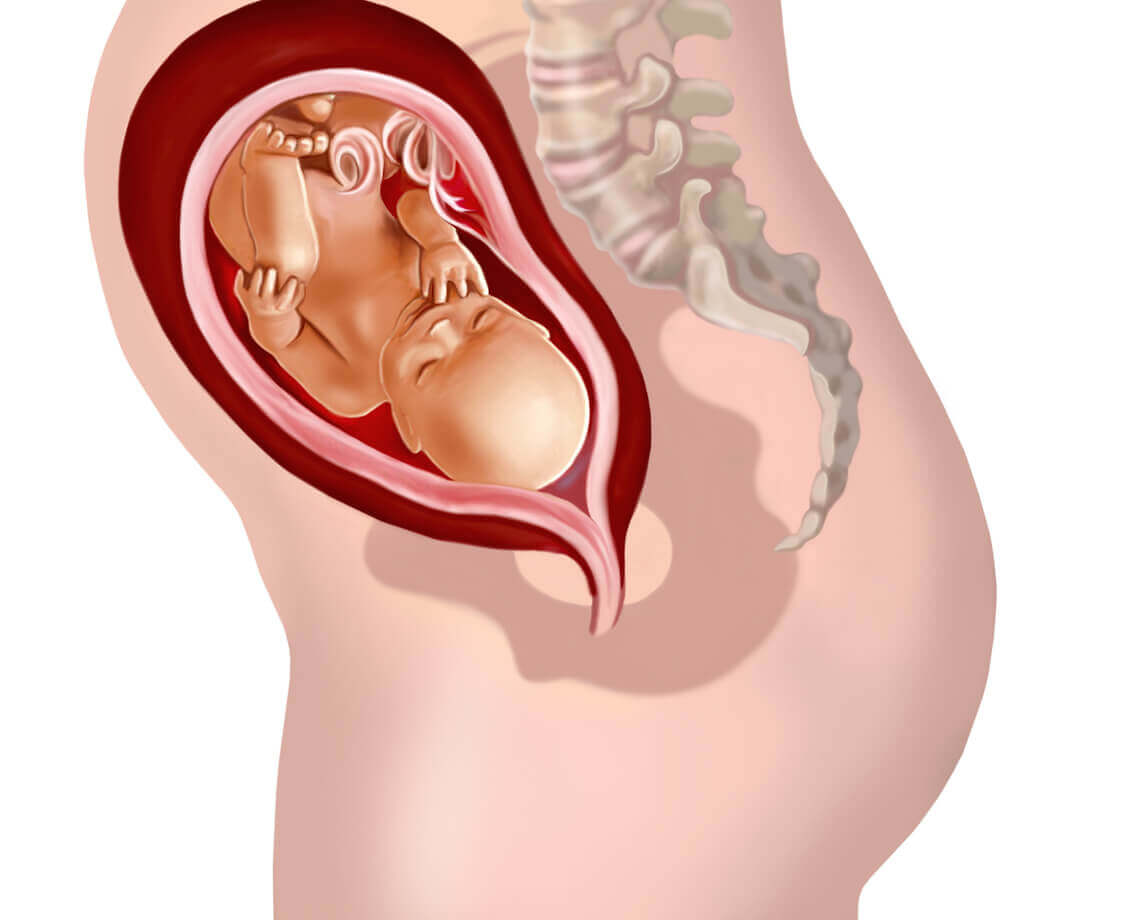Vaginal Examinations in Pregnancy: What You Should Know

Vaginal examinations are an exploratory procedure that a specialist performs during labor in order to assess its evolution and the state of the genital organs.
Because it’s an invasive test, its performance must follow strict clinical criteria and be performed by trained professionals. Similarly, the frequency of performance during the birthing process should be minimized.
Let’s see more about this diagnostic test, its indications, the procedure, and under what conditions it’s necessary to avoid it.
Why are vaginal examinations performed?
Although uncomfortable, vaginal examinations are physical examinations that provide important information about the state of the maternal and fetal tissues during labor. They allow doctors to determine the following parameters:
- Consistency of the cervix: If it’s soft, medium, or hard.
- Effacement or thinning of the cervix.
- Uterine dilation: This is done through palpation of the diameter of the cervix.
- Presentation of the baby: Cephalic if the head is palpated, or breach if the baby is in the seated position.
- Presentation height: This is the position of the baby in relation to the bone structure of the maternal pelvis.
- Lowering and rotating the baby’s head in the birth canal.
- Complications related to labor: Such as a transverse presentation, a prolapsed cord, or other abnormality that may put the well-being of the baby at risk.

How are vaginal examinations done?
As vaginal examinations are an invasive and risky test, they should only be performed by trained personnel under the correct aseptic guidelines. For example, with their hands clean and covered by sterile gloves.
Before performing the exam, the specialist will ask for your permission and what they’re going to do. At this time, you can talk about your doubts, such as knowing what the purpose of the procedure is.
Then, they’ll instruct you to lie on the table on your back, with your knees bent and your legs spread and resting on the table.
Next, the doctor will insert their index and middle fingers into your vagina to palpate the cervix and make their respective assessment. It’s possible that this is somewhat uncomfortable, due to the pressure that’s exerted on such a sensitive area in those times.
When are vaginal examinations performed?
This procedure is usually done during labor to assess progression. Normally, a professional will first perform the exam when your first arrive at the hospital, in the context of the initial evaluation, in order to establish what stage of labor you’re in.
However, it may also be necessary to perform it during pregnancy in order to assess the state of the tissues in the event of a threatened miscarriage or cervical insufficiency.
How many times can a doctor perform a vaginal examination?
Although there’s no exact number of times, it’s best to perform few examinations during labor. First, because they’re annoying, and second, because they can increase the risk of infections.
According to the WHO, the frequency of vaginal exams should be minimized to avoid these outcomes. In this sense, vaginal examinations are recommended at four-hour intervals to assess the progression of labor. It’s worth clarifying that when progress isn’t found over time, it’s necessary to take other precautions and that’s why the reiteration of the test is justified.
Similarly, this procedure should be performed only with the approval of the pregnant woman, who may also require that this examination be performed by her family doctor or trusted midwife.

In what circumstances are vaginal examinations contraindicated?
This exploratory test is contraindicated in some situations such as those described below:
- Previous placenta
- Vaginal bleeding
- Transverse or breech fetal presentation
Some final considerations
As you’ve seen, vaginal examinations are a very useful procedure for health professionals during childbirth. However, they’re not an advisable practice during pregnancy, due to the risk of causing injury and infection.
For your peace of mind, this is a topic that you can discuss with your doctor or midwife before giving birth. They’ll guide you regarding the recommended frequency and the need for their completion. And remember that in the case that you don’t want to accept them, you must let the professional know in advance.
Vaginal examinations are an exploratory procedure that a specialist performs during labor in order to assess its evolution and the state of the genital organs.
Because it’s an invasive test, its performance must follow strict clinical criteria and be performed by trained professionals. Similarly, the frequency of performance during the birthing process should be minimized.
Let’s see more about this diagnostic test, its indications, the procedure, and under what conditions it’s necessary to avoid it.
Why are vaginal examinations performed?
Although uncomfortable, vaginal examinations are physical examinations that provide important information about the state of the maternal and fetal tissues during labor. They allow doctors to determine the following parameters:
- Consistency of the cervix: If it’s soft, medium, or hard.
- Effacement or thinning of the cervix.
- Uterine dilation: This is done through palpation of the diameter of the cervix.
- Presentation of the baby: Cephalic if the head is palpated, or breach if the baby is in the seated position.
- Presentation height: This is the position of the baby in relation to the bone structure of the maternal pelvis.
- Lowering and rotating the baby’s head in the birth canal.
- Complications related to labor: Such as a transverse presentation, a prolapsed cord, or other abnormality that may put the well-being of the baby at risk.

How are vaginal examinations done?
As vaginal examinations are an invasive and risky test, they should only be performed by trained personnel under the correct aseptic guidelines. For example, with their hands clean and covered by sterile gloves.
Before performing the exam, the specialist will ask for your permission and what they’re going to do. At this time, you can talk about your doubts, such as knowing what the purpose of the procedure is.
Then, they’ll instruct you to lie on the table on your back, with your knees bent and your legs spread and resting on the table.
Next, the doctor will insert their index and middle fingers into your vagina to palpate the cervix and make their respective assessment. It’s possible that this is somewhat uncomfortable, due to the pressure that’s exerted on such a sensitive area in those times.
When are vaginal examinations performed?
This procedure is usually done during labor to assess progression. Normally, a professional will first perform the exam when your first arrive at the hospital, in the context of the initial evaluation, in order to establish what stage of labor you’re in.
However, it may also be necessary to perform it during pregnancy in order to assess the state of the tissues in the event of a threatened miscarriage or cervical insufficiency.
How many times can a doctor perform a vaginal examination?
Although there’s no exact number of times, it’s best to perform few examinations during labor. First, because they’re annoying, and second, because they can increase the risk of infections.
According to the WHO, the frequency of vaginal exams should be minimized to avoid these outcomes. In this sense, vaginal examinations are recommended at four-hour intervals to assess the progression of labor. It’s worth clarifying that when progress isn’t found over time, it’s necessary to take other precautions and that’s why the reiteration of the test is justified.
Similarly, this procedure should be performed only with the approval of the pregnant woman, who may also require that this examination be performed by her family doctor or trusted midwife.

In what circumstances are vaginal examinations contraindicated?
This exploratory test is contraindicated in some situations such as those described below:
- Previous placenta
- Vaginal bleeding
- Transverse or breech fetal presentation
Some final considerations
As you’ve seen, vaginal examinations are a very useful procedure for health professionals during childbirth. However, they’re not an advisable practice during pregnancy, due to the risk of causing injury and infection.
For your peace of mind, this is a topic that you can discuss with your doctor or midwife before giving birth. They’ll guide you regarding the recommended frequency and the need for their completion. And remember that in the case that you don’t want to accept them, you must let the professional know in advance.
All cited sources were thoroughly reviewed by our team to ensure their quality, reliability, currency, and validity. The bibliography of this article was considered reliable and of academic or scientific accuracy.
- Carvajal, J (2017). Manual de obstetricia y ginecología. VIII edición 2017. Escuela de medicina de la universidad pontificia de Chile.
- Gonzales, C (2010). Conducta del Cuello Uterino Durante el Embarazo, Parto y Puerperio. Ginecol Obstet Mex 2010;78(2):121-127
- Organización Mundial de la Salud (2015). Recomendaciones de la OMS para la conducción del trabajo de parto. Recuperado de: https://www.who.int/topics/maternal_health/directrices_OMS_parto_es.pdf
This text is provided for informational purposes only and does not replace consultation with a professional. If in doubt, consult your specialist.








